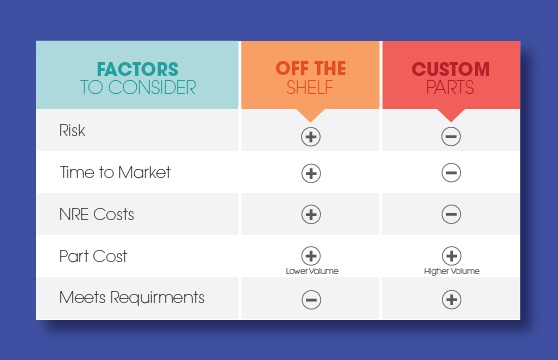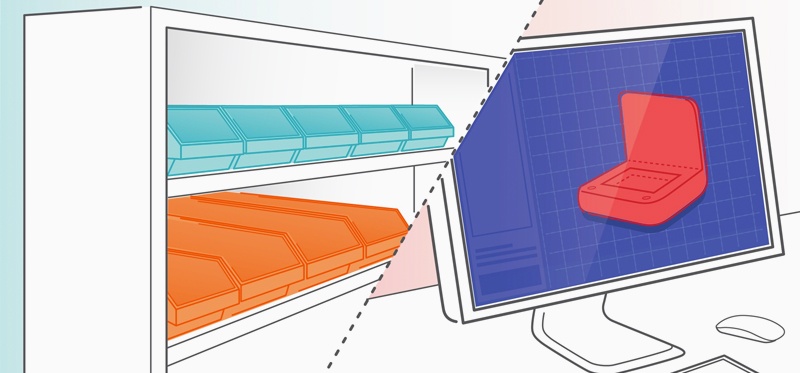Most engineers and product designers have run up against the same problem when designing a product. Your medical device design contains a number of parts and you come to a fork in the road: should you design a component from scratch, or go to the internet and your dusty stack of catalogs to see what is already available off the shelf (OTS)? Whether your design requires pumps, gears, or simple parts like shafts and gaskets, the decision to choose custom versus OTS components is usually based on the product into which it is going. You will consider design intent, time to market, and the overarching cost.
Off The Shelf (OTS)
You’ve decided to forgo the time and effort of CAD, drawings, tolerance analysis, and interfacing with potential contract manufacturers and chosen instead to buy preexisting components. Although there is a long list of benefits, the down sides could cause you to change direction. A part that is considered off-the-shelf (OTS) already exists and is usually readily available. A simple example is fluid pumps; there are thousands of pumps available from hundreds of companies from all over the world. While this may be a critical component to your product, your company may not be in the business of designing pumps. Timing and personnel constraints may cause management to direct you to shop around for a pump that suits your needs. In the hypothetical case of our pump, we would need to narrow our search by type, usually based on the application. At this point, it may be wise to consult with a component supplier to help narrow things down. A gear pump, diaphragm pump, and peristaltic pump all move fluids, but they do so at very different pressures and accuracies. You still need to decide which is more important to the final product. In many cases, a component supplier will be able to recommend a size and direction.

Often, one of the biggest benefits of buying OTS is that the component supplier will be able to give you all of the performance and test data that an engineer would have had to find through theory, simulation, and empirical testing. Life test data is one of the hardest data sets to obtain yet one of the most useful. Many suppliers will stand by their product, help to remedy or address warranty issues with their products, or help with best practices in implementation and assembly.
With so many benefits, it is easy to think that buying OTS components is the way to go. However, there are a few substantial drawbacks. The odds are pretty good that you will not be able to find exactly what you need. In almost every case, such limitations will cause the OTS component to drive the design, rather than the opposite. This could be anything from physical dimensions and mounting points to performance or life expectancy, which means that you are forced into a part or an assembly that is either overkill or subpar.
Obsolescence is also a real problem. Things may be going great with production and sales, until the component supplier informs you that they will be discontinuing the product that you buy from them. This puts you right back at the starting line. A scaled-back version of this issue occurs when the supplier makes changes to their component. This sometimes requires extensive supplier audits and requalification of the component. Your supplier may do this as a cost savings measure or to appease a larger, more lucrative customer. Either way, it is not something over which you have control. Similarly, you are at the mercy of this supplier for timely delivery or other contractual issues, such as minimum order quantities (MOQ) or unscheduled price increases.
Custom Designed Components
Many engineers and product development companies design products for highly specialized industries and may lean towards designing custom components. This may be because the product must perform very specific functions with precise accuracy. In these cases, budget is less of a concern. On the other hand, fast-turn consumer products are more likely to have these generalized OTS components. Because the specifications of the overall product are known, the component can be designed to have the exact fit, form, and function required. With a custom designed component, you can also have control over the quality and tolerances as well. If your company has internal manufacturing, you will not be reliant on any other company for delivery, and you will also be able to iterate your design more quickly. Even if you are reliant on a contract manufacturer to manufacture your in-house designed part, you may still have a more reliable supply chain compared to OTS suppliers. Moreover, any components that are designed in-house will be able to be patent-protected by the company. This means that competitors will have a more difficult time duplicating your design, and it could be an added revenue stream for the company in the future.
The perceived cost-benefit depends on a lot of criteria. The upfront cost of tooling, setting up an assembly line, or other capital expenses could negate the per-part cost savings of designing in house. Building your components in large quantities over many years may make this method worthwhile. Ultimately, quantity is going to be one of the biggest drivers in ROI realization.
The predominant downside of designing in-house is the time and level of expertise required to design the component. Let’s consider the fluid pump again: You are an engineer working for a medical device company, and a new product will make use of an infusion pump. Your company has not made or used infusion pumps in the past. In the conversation of whether or not to make this in-house, you must now consider the time and effort to become experts in this area of design, the nuances of manufacturing, navigating the intellectual property in the area, and regulatory compliance. Along with building the component to your specifications, it is now up to you to test it in a statistically significant quantity under various use case scenarios. Depending on the product, this could mean highly accelerated life testing (HALT), environmental, or regulatory testing. If this is going to be a major product for your company, or if there is nothing on the market that suits your needs, then taking this path may be justified.
Like many other decisions in engineering and manufacturing, deciding to use OTS or custom parts is not a simple choice, and one way or the other, it should probably not be a companywide blanket policy. The advantages and disadvantages must be determined and understood. Thus, supply chain, marketing, upper management, and other groups outside of engineering need to be involved. Any company that has developed a product has likely been faced with this decision, and the majority would probably reconsider some of their decisions in hindsight. This is all a large part of the engineering business and a valuable learning experience for engineers to undergo.
